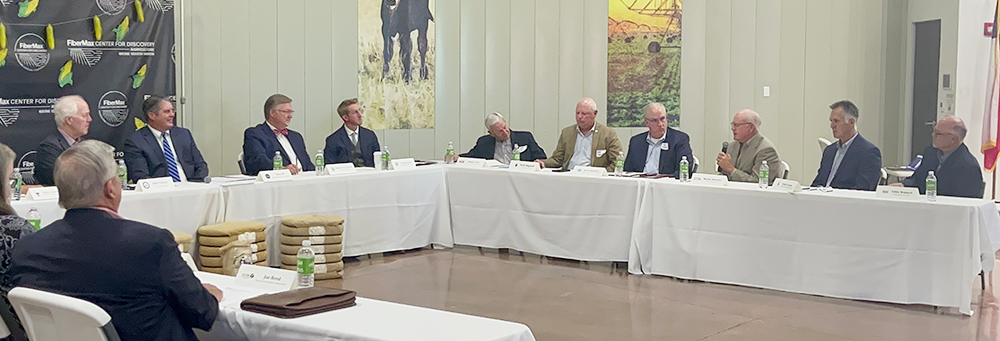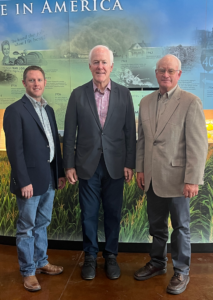Welcome to the July 17, 2023 issue of Cotton News, a service provided by Plains Cotton Growers Inc. for the cotton industry in the Texas High Plains and beyond.

PCG President Martin Stoerner discusses production challenges at the West Texas Farm Bill Roundtable with Sen. John Cornyn (R-Texas)
West Texas Farm Bill Roundtable with Sen. John Cornyn (R-Texas)
“Agriculture is a very high risk, high dollar enterprise,” said Kody Carson, past chairman of National Sorghum Producers. “Our farm bill budget is two-tenths of one percent of the U.S. budget. But if that’s too much to ask to feed underserved children and underserved individuals in the U.S., then we might ought to look at our priorities a little bit differently. Farmers aren’t asking for a handout. We’re asking for a level playing field in the world markets and in our trade negotiations so that we are viable to take care of the U.S. people that we love and believe in.”
The West Texas Farm Bill Roundtable with Sen. John Cornyn (R-Texas) was held Monday, July 17, at the FiberMax Center for Discovery in Lubbock, Texas.

PCG CEO Kody Bessent, Sen. John Cornyn (R-Texas) and PCG President Martin Stoerner.
Moderated by Tom Sell of Combest, Sell & Associates, agricultural industry groups representing research and education, cotton, corn, dairy, sorghum and wheat, gathered to voice their concerns and needs to the Texas Senator.
While there were several cotton producers at the table, solely representing cotton were Kevin Brinkley, president and CEO of Plains Cotton Cooperative Association and Martin Stoerner, Plains Cotton Growers Inc. President.
Discussion from all participants centered on the challenges of doing business as an agricultural producer, yet much appreciation was shown the Senator for his support of the industry and his recognition of the differences in geographic areas.
“We need to make sure that West Texas is heard in Washington,” Cornyn added. “It’s very different farming here than it would be in Iowa or Michigan. There is no ‘one-size-fits-all’ approach that works with legislation like the Farm Bill, which encompasses a diverse array of products, practices and landscapes.”
At the conclusion of the roundtable discussion, a press conference was held where reporters asked Cornyn about Farm Bill status and challenges with the legislation.
He said it was most probable that a Farm Bill would not be passed by the end of September, but rather extended toward the end of the year.
“That doesn’t mean the work will stop,” he added. “The committees just need a little more time to write an effective bill to help our farm families.”
He also noted that working across the aisle takes time, but that the bipartisan nature of the Farm Bill is what makes it effective. Cornyn said he understands and believes the Farm Bill to be of the highest priority to ensure our nation’s farmers and ranchers are able to feed and clothe the world while also staying in business.
“We appreciate the Senator for supporting us as he has done for so long and coming here today to listen to what we need,” Stoerner said. “We were able to have a good discussion with Sen. Cornyn in Washington D.C. back in April and know he is a viable ally for cotton and all of agriculture in Congress.”
Crop Scan Ag Report with Kerry Siders, Texas A&M AgriLife Extension Agent-IPM for Cochran, Hockley and Lamb Counties
This report was originally published by Cotton Grower.
Cotton ranges from 7 to 14 true leaves with square set/retention averaging a good +85%. I am just now starting to see first bloom in the more advanced fields. Generally, it will be after July 20 before we see cotton beginning to bloom, if not later in a good majority.
Our last effective bloom date (the date on which we can say with a high percent chance that a bloom will result in a harvestable boll) ranges from August 10-15, from Morton to Ropesville. So, if you do not begin to bloom until August 1, this gives you about 12 days of good bloom period, or time for about four first position bolls to be formed. In that scenario, yield is limited.
A field which begins to bloom on July 15 has about a 28-day effective bloom period, which can result in ~9 first position bolls. This is not counting second or possibly third positions in either case.
Cotton insect pests remain quiet. In the IPM Scouting Program, I have noted only a handful of adult fleahoppers. To date, none of these infestations have reached a threshold to justify treatment. Weeds continue to be the most dominant pest currently. A long-varied list of weed species is noted throughout the area, with Palmer amaranth still at the top. Remember, these weeds serve as host to many of our crop pests.
Another cotton issue that I am seeing and am concerned about as we move into another very hot period is heavy wheat stubble which served a great purpose back a few weeks ago as protection from the various elements, mostly wind. Now, however, it can be a detriment to the cotton since intact stubble can wick moisture from the soil.
I would encourage you to somehow break or sever that stem/straw from the roots. Using a sweep or knife to undercut this will help, or I have even seen stalk chopper units moved into the row middle and used to lay that stubble down, breaking that continuum of straw and roots and limiting the wicking effect.